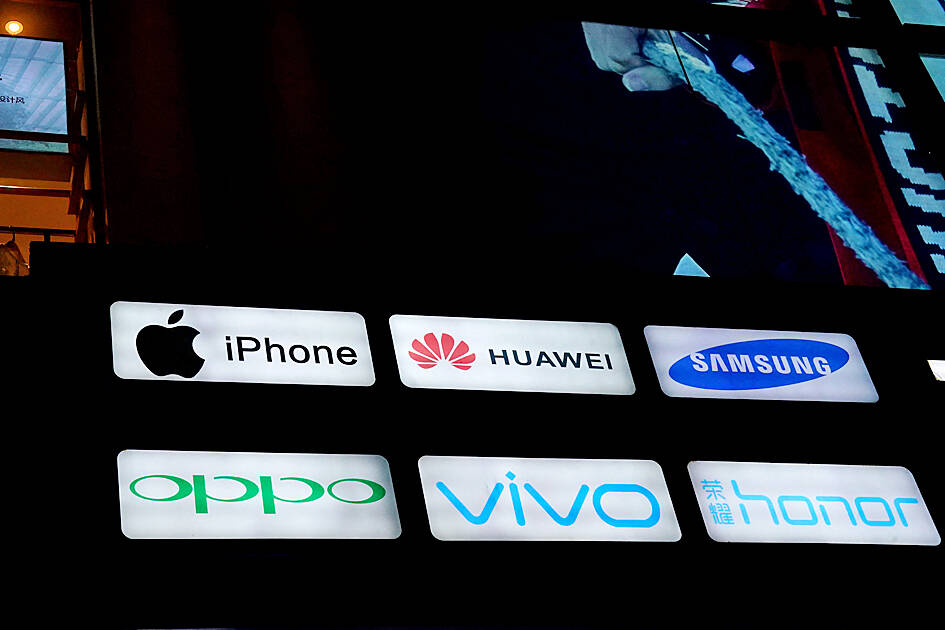China’s smartphone sales fell 13 percent year-on-year last year, the largest plunge for the sector in a decade as consumers spent cautiously, market research firm International Data Corp (IDC) said yesterday.
The total number of devices shipped was 286 million, down from 329 million last year, IDC researchers in a report.
That meant total sales volume was the lowest since 2013, and the first time since then that annual sales have dropped below 300 million, IDC said.

Photo: Reuters
Android handset maker Vivo Communication Technology Co (維沃) was the top-selling brand last year, with a market share of 18.6 percent, although its total shipments fell 25.1 percent year-on-year.
Honor Terminal Co (榮耀) ranked as the second best-selling brand, with shipments growing more than 34 percent, albeit from a low base.
Apple Inc was the third best-selling phone brand last year, tied with Oppo Mobile Telecommunications Corp (歐珀).
Apple’s overall sales fell 4.4 percent year-on-year, broadly outperforming the market downturn.
In the fourth quarter of last year, despite being the top-selling brand in the three-month period, year-on-year sales for iPhones remained down, as supply chain issues caused by worker unrest at manufacturer Foxconn Technology Group’s (富士康科技集團) plant in Zhengzhou compounded demand that was already worse than expected, IDC said.
Strict COVID-19 controls in China, which ramped up in the spring of last year across several cities, weighed heavily on its economy, which slumped to one of its worst levels in nearly half a century last year.
The plunge in smartphone sales in China reflected the sector’s performance globally. Last year, global smartphone shipments hit 1.2 billion units, the lowest since 2013 and a year-on-year fall of more than 11 percent, according to IDC.

PATENTS: MediaTek Inc said it would not comment on ongoing legal cases, but does not expect the legal action by Huawei to affect its business operations Smartphone integrated chips designer MediaTek Inc (聯發科) on Friday said that a lawsuit filed by Chinese smartphone brand Huawei Technologies Co (華為) over alleged patent infringements would have little impact on its operations. In an announcement posted on the Taiwan Stock Exchange, MediaTek said that it would not comment on an ongoing legal case. However, the company said that Huawei’s legal action would have little impact on its operations. MediaTek’s statement came after China-based PRIP Research said on Thursday that Huawei filed a lawsuit with a Chinese district court claiming that MediaTek infringed on its patents. The infringement mentioned in the lawsuit likely involved

Taipei is today suspending work, classes and its US$2.4 trillion stock market as Typhoon Gaemi approaches Taiwan with strong winds and heavy rain. The nation is not conducting securities, currency or fixed income trading, statements from its stock and currency exchanges said. Authorities had yesterday issued a warning that the storm could affect people on land and canceled some ship crossings and domestic flights. Taiwan Semiconductor Manufacturing Co (TSMC, 台積電) expects its local chipmaking fabs to maintain normal production, the company said in an e-mailed statement. The main chipmaker for Apple Inc and Nvidia Corp said it has activated routine typhoon alert

GROWTH: TSMC increased its projected revenue growth for this year to more than 25 percent, citing stronger-than-expected demand for AI devices and smartphones The Taiwan Institute of Economic Research (TIER, 台灣經濟研究院) yesterday raised its forecast for Taiwan’s GDP growth this year from 3.29 percent to 3.85 percent, as exports and private investment recovered faster than it predicted three months ago. The Taipei-based think tank also expects that Taiwan would see a 8.19 percent increase in exports this year, better than the 7.55 percent it projected in April, as US technology giants spent more money on artificial intelligence (AI) infrastructure and development. “There will be more AI servers going forward, but it remains to be seen if the momentum would extend to personal computers, smartphones and

Catastrophic computer outages caused by a software update from one company have once again exposed the dangers of global technological dependence on a handful of players, experts said on Friday. A flawed update sent out by the little-known security firm CrowdStrike Holdings Inc brought airlines, TV stations and myriad other aspects of daily life to a standstill. The outages affected companies or individuals that use CrowdStrike on the Microsoft Inc’s Windows platform. When they applied the update, the incompatible software crashed computers into a frozen state known as the “blue screen of death.” “Today CrowdStrike has become a household name, but not in